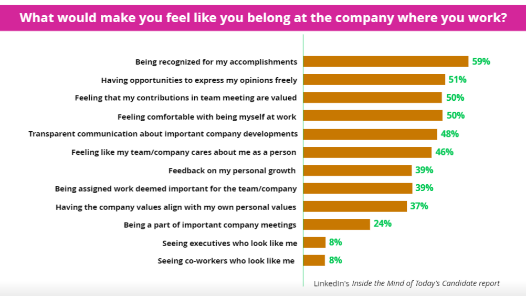Workplace Culture: What Is It? Why Does It Matter?
According to Dr. Pragya Agarwal, author of Sway, “workplace culture is the shared values, belief systems, attitudes and the set of assumptions that people in a workplace share. Leadership and management influence the workplace culture to a huge extent. A positive workplace culture improves teamwork, raises morale, increases productivity and efficiency, and enhances retention. Job satisfaction, collaboration, and work performance are all enhanced. And, most importantly, a positive workplace environment reduces stress in employees.”
Sounds pretty important, like something every company should pay attention to.
Unfortunately:
- 56% of employers say they are unable to actively manage culture because they lack leadership support; 45% say they don’t have enough time or resources (CultureIQ)
- 52% of HR pros cite management buy-in as the biggest barrier to strengthening culture (CultureIQ)
- 42% of employees feel that executive leadership does not contribute to a positive company culture (Execu-Search)
These barriers all point toward management and leadership. As Agarwal said “Leadership and management influence the workplace culture to a huge extent.” In too many cases, it appears, leadership and management inhibit healthy culture, and that’s not good for business.
Is Your Company Culture Good for Business?
Most agree that company culture can be a positive force in business.
- 90% of CEOs and CFOs indicated a strong belief that the quality of a company’s culture is inextricably linked with its financial success as well as its perceived “value” in the world. (Columbia Business School, Shiva Rajgopal)
- 73% of employers believe a great corporate culture gives their organizations a competitive edge (CultureIQ)
- Companies that were thought of, spoken of, and “graded” highly by their employees generated higher profits even years later. (University of South Florida)
- 49% of employees say culture influences their employee experience more than the physical environment (22%) or the technology they use to do their jobs (29%) (YouEarnedIt)
The impact of a strong, healthy company culture is seen in financial success, brand strength, competitive advantages, and employee engagement.
Companies that aren’t intentionally managing their culture are missing out on these benefits.
Creating and sustaining culture is a deliberate and strategic endeavor. You can’t leave culture up to chance or expect it to organically evolve. Since culture is the composite of “the shared values, belief systems, attitudes and the set of assumptions that people in a workplace share,” there first needs to be a mechanism for determining what the shared values will be. Then there needs to be an activation and expectation for these shared values to come to life and constantly edify and embed themselves.
This attention to culture doesn’t happen in a vacuum. It’s not the work of HR alone or of a culture committee alone. Remember, “Leadership and management influence the workplace culture to a huge extent.” Culture must be demonstrated, modeled, maintained, championed, and expected at the top.
That’s how you’ll define culture and enjoy the fruits that come with it.

To download additional stats on employee engagement and workplace culture, check out this comprehensive resource from Access Perks.
What Does It Take to Create a Culture that Fuels Employee Engagement?
It bears repeating that this is largely up to the executive team and senior managers. Their choices and behaviors signal to others what matters most.
- The top three factors that contribute to culture problems are the tone set by executive management, the tone set by middle management, and an excessive focus on short-term goals. (PwC)
- Cultures that support unplugging have employees that are more engaged and more likely to report feeling that their employer cares about them as a person (64% to 43%) and that their job is important (73% to 57%) (Project: Time Off)
- Only 7.5% of teams work in a culture where there is always a direct connection between the work being done and the purpose of what the organization does in the world. In those teams, executive leaders proactively work to shape and mold the culture daily. It's weaved in all areas of the business from hiring, to employee development, to constant communication. (Daniel Coyle, The Culture Code)
Having a strong, healthy workplace culture also creates a sense of belonging for employees. That’s good for employee engagement and retention. The longer people stick around, the stronger the culture will be. People who understand the culture and believe in it will naturally reinforce and model it.
To create a culture and give people a sense of belonging, consider the graph below that gives specific, actionable ideas you can implement right away.
Next Steps for Creating the Workplace Culture You Want
According to Culture IQ, the most popular methods to actively manage company culture and drive employee engagement are:
- drafting employee engagement surveys (55%),
- creating culture committees and events (29%)
- offering employee resource groups (20%)
These are the most popular, but they leave out the most important component. “Leadership and management influence the workplace culture to a huge extent.”
The place to start is at the top. Senior executives should define the values of the organization and how those are to be expressed in actions and decisions. They should know what they, themselves, must do to model the desired culture. They should understand just how significant the impact of a strong, healthy culture and employee engagement are on business results.
People First Productivity Solutions can help you facilitate and activate culture choices for strategic business impact. Don’t leave your culture up for grabs.
